The holiday lights are down, the shiny red bows have been packed away, and we find ourselves left with the drab winter landscape that will surround us until spring. January brings the promise of a new and better year, but the central Ohio landscape is not exactly a reflection of our inner sense of hope and rejuvenation! Although it may not be possible to experience the pastel flowers of spring, the brightly colored butterflies of summer, or the blazing reds of fall in our “Great Outdoors” at this time of year, winter need not be as bland and colorless as you may think.
The first plants that come to mind when people think of the winter landscape are Pine Trees (Pinus), Spruce Trees (Picea), and Holly Shrubs (Ilex). Along with Boxwoods (Buxus), Yews (Taxus), Arborvitaes (Thuja), Junipers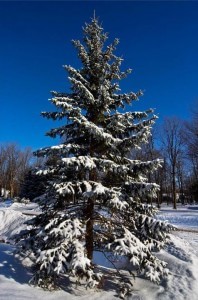 (Juniperus), and Falsecypress (especially Chamaecyparis pisifera ‘Gold Mop’) these plants are “the old stand-bys” for winter interest. Evergreen trees and shrubs are an important component of any planting plan because they provide structure and weight to your landscape all year long, and most especially in the winter when your beds would otherwise be empty or “just sticks.” Often overlooked in the summer, evergreen trees and shrubs actually deliver a nice splash of color during the winter when we primarily see a landscape of browns and grays. Additionally, these evergreens provide important shelter for the birds that stay up north with us for the winter. Many groundcovers, such as English Ivy (Hedera helix) and Vinca (Vinca minor), are also evergreen and provide a lush green carpet where there would otherwise be an empty mulch bed.
(Juniperus), and Falsecypress (especially Chamaecyparis pisifera ‘Gold Mop’) these plants are “the old stand-bys” for winter interest. Evergreen trees and shrubs are an important component of any planting plan because they provide structure and weight to your landscape all year long, and most especially in the winter when your beds would otherwise be empty or “just sticks.” Often overlooked in the summer, evergreen trees and shrubs actually deliver a nice splash of color during the winter when we primarily see a landscape of browns and grays. Additionally, these evergreens provide important shelter for the birds that stay up north with us for the winter. Many groundcovers, such as English Ivy (Hedera helix) and Vinca (Vinca minor), are also evergreen and provide a lush green carpet where there would otherwise be an empty mulch bed.
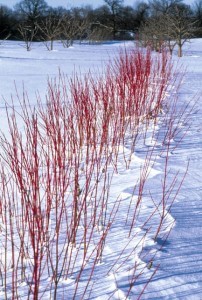 Although any discussion of winter landscape interest must begin with evergreens, it most definitely does not have to end there. One winter interest plant that is gaining in popularity is the Red Twig Dogwood (Cornus alba) shrub. Some cultivars of this plant have spring flowers, variegated foliage, and good fall color; but it is winter when they truly stand out! As the weather gets colder you will notice the brown branches beginning to turn red, with the newest stems having the most vibrant color. Varieties of this plant boast colorful stems ranging from bright red to orange-red to coral red. Another interesting selection is the Red Twig Dogwood’s cousin, the Yellow Twig Dogwood (Cornus sericea ‘Silver & Gold’). The bright stems of the Red Twig and Yellow Twig Dogwood especially pop when planted in mass and surrounded by a blanket of fresh snow!
Although any discussion of winter landscape interest must begin with evergreens, it most definitely does not have to end there. One winter interest plant that is gaining in popularity is the Red Twig Dogwood (Cornus alba) shrub. Some cultivars of this plant have spring flowers, variegated foliage, and good fall color; but it is winter when they truly stand out! As the weather gets colder you will notice the brown branches beginning to turn red, with the newest stems having the most vibrant color. Varieties of this plant boast colorful stems ranging from bright red to orange-red to coral red. Another interesting selection is the Red Twig Dogwood’s cousin, the Yellow Twig Dogwood (Cornus sericea ‘Silver & Gold’). The bright stems of the Red Twig and Yellow Twig Dogwood especially pop when planted in mass and surrounded by a blanket of fresh snow!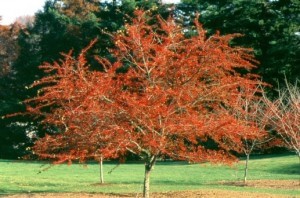
Planting trees and shrubs that maintain their berries throughout the winter is another way to add color to your winter landscape. The familiar Blue Holly (Ilex x meservae) has a deciduous relative, Winterberry Holly (Ilex verticillata), that maintains clusters of bright red berries on its bare branches throughout the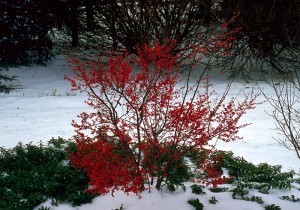 winter. The Winter King Hawthorn (Crataegus viridis ‘Winter King’) is a great ornamental tree that also has red berries during the winter. The berries can be especially striking when viewed against a backdrop of Spruce trees! A less frequently used landscape plant that retains its berries through much of the winter is Beautyberry (Callicarpa dichotoma). If you have room for this sucker spreading shrub, you will enjoy the
winter. The Winter King Hawthorn (Crataegus viridis ‘Winter King’) is a great ornamental tree that also has red berries during the winter. The berries can be especially striking when viewed against a backdrop of Spruce trees! A less frequently used landscape plant that retains its berries through much of the winter is Beautyberry (Callicarpa dichotoma). If you have room for this sucker spreading shrub, you will enjoy the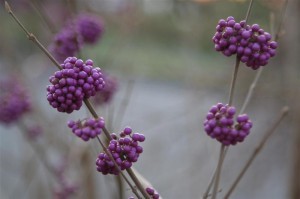 profuse clusters of lavender berries that remain on the branches through at least the first half of winter. An added bonus to using these plant selections is that you will be providing a valuable food source for birds during a time of year when sustenance can be scarce.
profuse clusters of lavender berries that remain on the branches through at least the first half of winter. An added bonus to using these plant selections is that you will be providing a valuable food source for birds during a time of year when sustenance can be scarce.
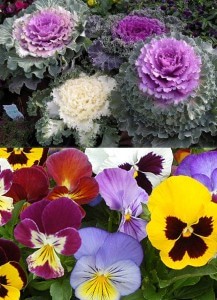 If it is flowers that you long to see in the winter, your choices may be limited, but there are a handful of options available to you. A popular practice in recent years has been to plant annual beds with Kale or, the somewhat paradoxically named, Hardy Pansies in the winter. Kale is a crinkly leafed relative of Cabbage, Broccoli, and Cauliflower. Although edible, the landscape varieties of Kale have been selected for their texture and purple or white color, rather than for their taste! Pansies are low growing biennials that are available in a wide range of
If it is flowers that you long to see in the winter, your choices may be limited, but there are a handful of options available to you. A popular practice in recent years has been to plant annual beds with Kale or, the somewhat paradoxically named, Hardy Pansies in the winter. Kale is a crinkly leafed relative of Cabbage, Broccoli, and Cauliflower. Although edible, the landscape varieties of Kale have been selected for their texture and purple or white color, rather than for their taste! Pansies are low growing biennials that are available in a wide range of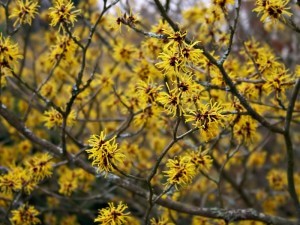 colors. Hardy enough to survive winters in Zone 4, Pansies are your best choice if a multitude of colorful flowers is your goal. One more winter flowering plant that should not be overlooked is the Vernal Witch-hazel (Hamamelis vernalis) shrub. During the warm days of January, and February you may notice these plants unfurling small clusters of orange or yellow spider-like petals. Much like us humans on cold days, you may also notice that these petals curl back up when the temperature drops. This survival technique helps the flowers to persist until March or April.
colors. Hardy enough to survive winters in Zone 4, Pansies are your best choice if a multitude of colorful flowers is your goal. One more winter flowering plant that should not be overlooked is the Vernal Witch-hazel (Hamamelis vernalis) shrub. During the warm days of January, and February you may notice these plants unfurling small clusters of orange or yellow spider-like petals. Much like us humans on cold days, you may also notice that these petals curl back up when the temperature drops. This survival technique helps the flowers to persist until March or April.
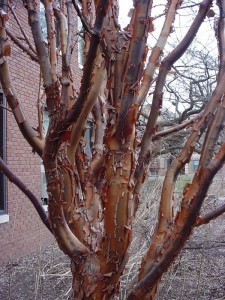 Interesting textures are another way that you can add interest to you winter landscape. The exfoliating bark of Oakleaf Hydrangeas (Hydrangea quercifolia), Paperbark Maples (Acer griseum), and London Planetrees (Platanus x acerifolia) can be very eye catching at a time when there are fewer colors around to distract from this unusual feature. The exposed white bark of the London Plantree can be especially striking on a night
Interesting textures are another way that you can add interest to you winter landscape. The exfoliating bark of Oakleaf Hydrangeas (Hydrangea quercifolia), Paperbark Maples (Acer griseum), and London Planetrees (Platanus x acerifolia) can be very eye catching at a time when there are fewer colors around to distract from this unusual feature. The exposed white bark of the London Plantree can be especially striking on a night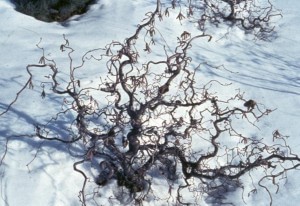 illuminated by a full moon! The dried flower heads of Hydrangea shrubs and seed heads of a variety of Ornamental Grasses add another attractive texture to the winter scenery. An additional interesting plant selection is Harry Lauder’s Walking Stick (Corylus avellana ‘Contorta’). The distinctive twisty curlicue branches of this shrub make it a unique standout year-round, but especially in the winter when the leaves have dropped and the branching pattern is on full display.
illuminated by a full moon! The dried flower heads of Hydrangea shrubs and seed heads of a variety of Ornamental Grasses add another attractive texture to the winter scenery. An additional interesting plant selection is Harry Lauder’s Walking Stick (Corylus avellana ‘Contorta’). The distinctive twisty curlicue branches of this shrub make it a unique standout year-round, but especially in the winter when the leaves have dropped and the branching pattern is on full display.
Winter may not be the most colorful time of year, but your “Great Outdoors” need not be drab and boring. The strategic use of a few plants that provide a burst of color or interesting texture can make your landscape really pop and stand out from the rest. A few splashes of interest can be a reminder that spring is just around the corner, and that may be just what you need to help you endure the rest of the winter!

